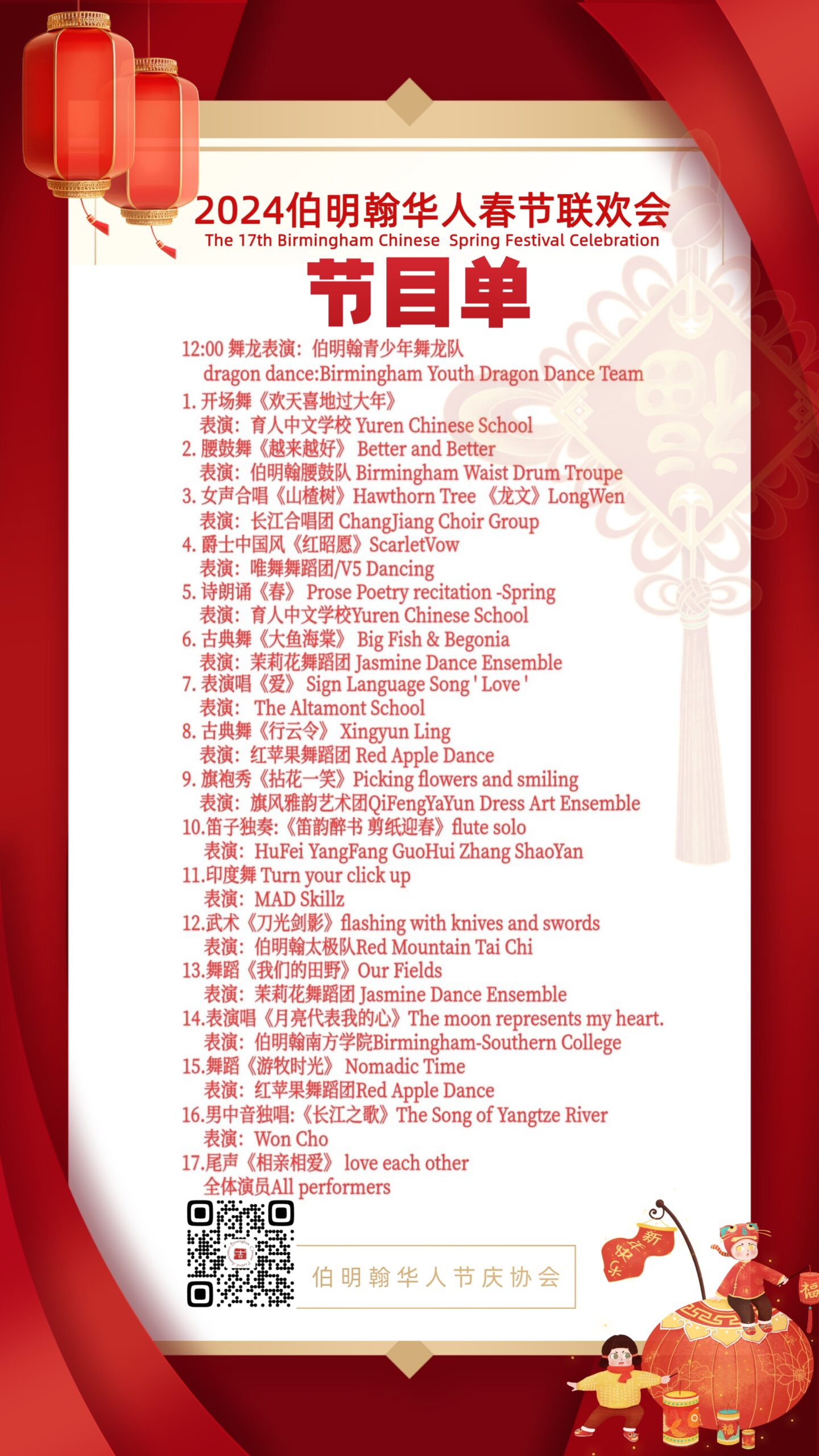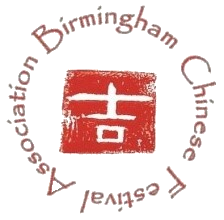Welcome to the
Birmingham Chinese
Festival Association
2024 Chinese New Year


History & Mission
History
The Birmingham Chinese Festival Association began with a casual lunch conversation at a restaurant between two friends in 2005 and has developed into the largest Chinese New Year Celebration in Alabama. The idea to launch a Chinese New Year festival similar to the one held in Atlanta by taking the advantage of that Birmingham Chinese Association (BCA) had had its annual Chinese New Year celebration within Chinese community. To consolidate the resource, promote the awareness of Chinese heritage in the city of Birmingham metropolitan area, they suggested bringing the function of Birmingham Chinese Association to the city level, They thought that it would be a rallying point for local Chinese Americans and a chance for the entire Birmingham community to unite to celebrate Chinese history and culture. This concept got the strongly supported by BCA, the Birmingham Public Library, the Birmingham Museum of Art, and local Chinese cultural institutions and organizations. The “Birmingham Chinese Festival Association” was named and Yue Li registered it at the secretary of State and recorded the articles of Birmingham Chinese Festival Association at the Probate Court of Jefferson County and Scotty Colson wrote the by-laws and facilitated the application process for the organization 501(c)(3) non-profit status.
Appropriately, the first meeting was held at the Birmingham City Hall. The president of BCA at that year, Wilma Hsu, became the president of BCFA and Dr. Chen of BCA was made vice-president, Scotty Colson was the treasurer.
The first meeting generated quite a bit of interest. Officers were elected, committees were named and planning began for the first festival. The next step was to secure sponsors, volunteers and implement the necessary actions to launch a successful festival.
The First Festival was held in February 2006 and began with an outdoor dragon dance and fireworks at Linn Park. The parade led people of all ages to the Birmingham Museum of Art which hosted art activities, dance and music performances, children’s film, and acrobats. The Birmingham Public Library also hosted indoor events. The entire event was extremely successful, and well-received, bringing about 1,500 visitors to downtown Birmingham.
The Birmingham Chinese Festival Association continues to organize this annual event at Boutwell Auditorium, with the dragon dance and parade in Linn Park and the student art exhibition at the Birmingham Museum of Art. The committee has rotated members over the years, but everyone involved is committed to advancing Chinese art and culture in Alabama. Each year, the celebration is themed around the corresponding Chinese zodiac symbol.
Be sure to join us for the Year of the Rat on January 25th, 2020!
Mission
To promote Chinese culture, festivals and strengthen multicultural connections in metro Birmingham communities.
- To foster amicable relations within the Chinese community in the Birmingham area.
- To foster good relations between the local ethnic Chinese population and the Birmingham community.
BCFA is organized exclusively for charitable, religious, educational and scientific purpose including for such purposes, the making of distributions to organizations that qualify as exempt organizations under section 501 ?(3) of the Internal Revenue Code, or corresponding section of any federal tax code
Chinese New Year, known in China as Spring Festival (春節 Chunjie), is the most important of the traditional Chinese holidays. It is sometimes called the Lunar New Year, especially by people outside China. The festival traditionally begins on the first day of the first lunar month (正月 zheng yue) in the Chinese calendar and ends on the 15th; this day is called Lantern Festival. Chinese New Year’s Eve is known as Chuxi (除夕, abbr. for 年除夕 Nian Chu Xi). It literally means “Year-pass Eve”.
Celebrated in areas with large populations of ethnic Chinese, Chinese New Year is considered a major holiday for the Chinese and has had influence on the new year celebrations of its geographic neighbours, as well as cultures with whom the Chinese have had extensive interaction.[citation needed] These include Taiwanese, Koreans, Mongolians, Nepalese, Bhutanese, Vietnamese, and formerly the Japanese before 1873. In Singapore, Indonesia, Malaysia, the Philippines, Thailand, and other countries with significant Chinese populations, Chinese New Year is also celebrated, largely by overseas Chinese, and has, to varying degrees, become part of the traditional culture of these countries. In United States, although Chinese New Year is not an official holiday, many ethnic Chinese hold large celebrations and U.S. Post issues New Year’s themed stamps in domestic and international rates.
Mythology
According to tales and legends, the beginning of Chinese New Year started with the fight against a mythical beast called the Nian or “Year” in Chinese. Nian would come on the first day of New Year to devour livestock, crops, and even villagers, especially children. To protect themselves, the villagers would put food in front of their doors at the beginning of every year and believed that after the Nian ate the food they prepared, it wouldn’t attack any more people. Once, people saw the Nian was scared away by a little child wearing red, they then understood that the Nian was afraid of color red. Hence, every time when New Year was about to come, the villagers would hang red lanterns and spring scroll on windows and doors. People also used firecrackers to frighten the Nian and from then on, the Nian never came to the village again and was eventually converted by Hongjunlaozu, a Taoist in the old time, and became his mount.
New Year Dates
The lunisolar Chinese calendar determines Chinese New Year dates. The calendar is also used in countries that have adopted or have been influenced by Han culture (notably the Taiwanese, Koreans, Japanese and Vietnamese) and may have a common ancestry with the similar New Years festivals outside East Asia (such as Iran, and historically, the Bulgars lands).
In the Gregorian calendar, Chinese New Year falls on different dates each year, a date between January 21 and February 20. This means that the holiday usually falls on the second (very rarely third) new moon after the winter solstice. In traditional Chinese Culture, lichun is a solar term marking the start of spring, which occurs about February 4. The dates of Chinese new year for the following years are as below:
2019 – February 2 – Pig year
2020 – January 25 – Rat year
2021 – February 13th – Ox year
2022 – February 5 – Tiger year
2023 – January 21 – Rabbit year
2024 – February 10 – Dragon year
2025 – February 1 – Snake year
2026 – February 21 – Horse year
2027 – February 6 – Sheep year
2028 – January 29 – Monkey year
2029 – February 17 – Rooster year
The Duanwu Festival (in Mandarin Chinese pronunciation) or Tuen Ng Festival (in Cantonese Chinese pronunciation) is a Chinese traditional and statutory holiday. It is a public holiday in mainland China and Taiwan, where it is called the “Duanwu Jie” and a public holiday in Hong Kong and Macau, where it is called the “Tuen Ng Jit”. In English it is also referred to as “Dragon Boat Festival”, after one of the traditional activities for the holiday.
The Duanwu Festival occurs on the fifth day of the fifth month of the Chinese calendar, giving rise to the alternative name of Double Fifth. In 2008, this falls on June 8. The focus of the celebrations includes eating zongzi, which are large rice wraps, drinking realgar wine, and racing dragon boats.
The Duanwu Festival has also been celebrated in other East Asian nations. For some equivalent or related celebrations in these countries, see Kodomo no hi in Japan, Dano in Korea, and Tet Doan Ngo in Vietnam.
The Mid-Autumn Festival, also known as the Moon Festival, or in Chinese, Zhongqiu Jie (traditional Chinese: 中秋節), is a popular harvest festival celebrated by Chinese people and Vietnamese people (even though they celebrate it differently), dating back over 3,000 years to moon worship in China’s Shang Dynasty. It was first called Zhongqiu Jie (literally “Mid-Autumn Festival”) in the Zhou Dynasty. The Mid-Autumn Festival is held on the 15th day of the eighth month in the Chinese calendar, which is usually around mid or late September in the Gregorian calendar. It is a date that parallels the autumn and spring Equinoxes of the solar calendar. The traditional food of this festival is the mooncake, of which there are many different varieties.
The Mid-Autumn Festival is one of the two most important holidays in the Chinese calendar, the other being the Chinese New Year, and is a legal holiday in several countries. Farmers celebrate the end of the summer harvesting season on this date. Traditionally, on this day, Chinese family members and friends will gather to admire the bright mid-autumn harvest moon, and eat moon cakes and pomeloes together. Accompanying the celebration, there are additional cultural or regional customs, such as:
Eating moon cakes outside under the moon
Putting pomelo rinds on one’s head
Carrying brightly lit lanterns, lighting lanterns on towers, floating sky lanterns
Burning incense in reverence to deities including Chang’e (嫦娥)
Planting Mid-Autumn trees
Collecting dandelion leaves and distributing them evenly among family members
Breaking culture barriers
Stories of the Mid-Autumn Festival
Houyi and Chang’e
While Westerners may talk about the “man on the moon”, the Chinese talk about the “woman on the moon”. The story of the fateful night when Chang’e was lifted up to the moon, familiar to most Chinese citizens, is a favorite subject of poets. Unlike many lunar deities in other cultures who personify the moon, Chang’e lives in the moon. Tradition places Houyi and Chang’e around 2170 BC, in the reign of the legendary Emperor Yao, shortly after that of Huang Di.
The Hare – Jade Rabbit
According to tradition, the Jade Rabbit pounds medicine, together with the lady, Chang’er, for the gods. Others say that the Jade Rabbit is a shape, assumed by Chang’e herself. You may find that the dark areas to the top of the full moon may be construed as the figure of a rabbit. The animal’s ears point to the upper right, while at the left are two large circular areas, representing its head and body.In this legend, three fairy sages transformed themselves into pitiful old men, and begged for food from a fox, a monkey, and a hare. The fox and the monkey both had food to give to the old men, but the hare, empty-handed, jumped into a blazing fire to offer his own flesh instead. The sages were so touched by the hare’s sacrifice and act of kindness that they let him live in the Moon Palace, where he became the “Jade Rabbit”.
The Lantern Festival a Chinese festival celebrated on the fifteenth day of the first month in the lunar year in the Chinese calendar. It is not to be confused with the Mid-Autumn Festival, which is also sometimes known as the “Lantern Festival” in locations such as Singapore, and Malaysia. During the Lantern Festival, children go out at night to temples carrying paper lanterns (免子燈 Tu Zi Deng) and solve riddles on the lanterns (猜燈謎 Cai Deng Mi). It officially ends Chinese New year.In ancient times, the lanterns were fairly simple, for only the emperor and noblemen had large ornate ones; in modern times, lanterns have been embellished with many complex designs. For example, lanterns are now often made in shapes of animals.The Lantern Festival is also known as the Little New Year since it marks the end of the series of celebrations starting from the Chinese New Year. Koreans celebrate this festival as the Daeboreum.
History
The 15th day of the 1st lunar month is the Chinese Lantern Festival because the first lunar month is called yuan-month and in the ancient times people called night Xiao. The 15th day is the first night to see a full moon. So the day is also called Yuan Xiao Festival in China. According to the Chinese tradition, at the very beginning of a new year, when there is a bright full moon hanging in the sky, there should be thousands of colorful lanterns hung out for people to appreciate. At this time, people will try to solve the puzzles on the lanterns and eat yuanxiao (glutinous rice ball) and get all their families united in the joyful atmosphere.
Earliest Origins
There are many different beliefs about the origin of the Lantern Festival. But one thing for sure is that it had something to do with celebrating and cultivating positive relationship between people, families, nature and the higher beings they believed were responsible for bringing/returning the light each year.
One legend tells us that it was a time to worship Taiyi, the God of Heaven in ancient times. The belief was that the God of Heaven controlled the destiny of the human world. He had sixteen dragons at his beck and call and he decided when to inflict drought,storms, famine or pestilence upon human beings. Beginning with Qinshihuang, the first emperor to unite the country, all subsequent emperors ordered splendid ceremonies each year. The emperor would ask Taiyi to bring favorable weather and good health to him and his people. Emperor Wudi of the Han Dynasty directed special attention to this event. In 104 BC, he proclaimed it one of the most important celebrations and the ceremony would last throughout the night.
Another legend associates the Lantern Festival with Taoism. Tianguan is the Taoist god responsible for good fortune. His birthday falls on the 15th day of the first lunar month. It is said that Tianguan likes all types of entertainment. So followers prepare various kinds of activities during which they pray for good fortune.
Young people were chaperoned in the streets in hopes of finding love. Matchmakers acted busily in hopes of pairing couples. The brightest lanterns were symbolic of good luck and hope. As time has progressed, however, the festival no longer has such implications nowadays.
Those who do not carry lanterns often enjoy watching informal lantern parades. In addition to eating tangyuan (湯圓), another popular activity at this festival is guessing lantern riddles (which became part of the festival since Tang Dynasty), which often contain messages of good fortune, family reunion, abundant harvest, prosperity and love.
6th century and beyond
Until the Sui Dynasty in the sixth century, Emperor Yangdi invited envoys from other countries to China to see the colorful lighted lanterns and enjoy the gala performances.By the beginning of the Tang Dynasty in the seventh century, the lantern displays would last three days. The emperor also lifted the curfew, allowing the people to enjoy the festive lanterns day and night. It is not difficult to find Chinese poems which describe this happy scene.
In the Song Dynasty, the festival was celebrated for five days and the activities began to spread to many of the big cities in China. Colorful glass and even jade were used to make lanterns, with figures from folk tales painted on the lanterns.
However, the largest Lantern Festival celebration took place in the early part of the 15th century. The festivities continued for ten days. Emperor Chengzu had the downtown area set aside as a center for displaying the lanterns. Even today, there is a place in Beijing called Dengshikou. In Chinese, Deng means lantern and Shi is market. The area became a market where lanterns were sold during the day. In the evening, the local people would go there to see the beautiful lighted lanterns on display.
Today, the displaying of lanterns is still a big event on the 15th day of the first lunar month throughout China. People enjoy the brightly lit night. Chengdu in Southwest China’s Sichuan Province, for example, holds a lantern fair each year in the Cultural Park. During the Lantern Festival,the park is literally an ocean of lanterns! Many new designs attract countless visitors. The most eye-catching lantern is the Dragon Pole. This is a lantern in the shape of a golden dragon, spiraling up a 27-meter-high pole, spewing fireworks from its mouth.
